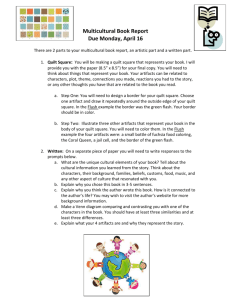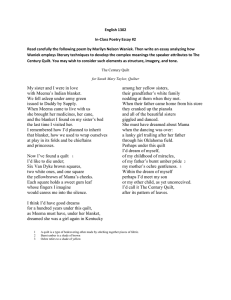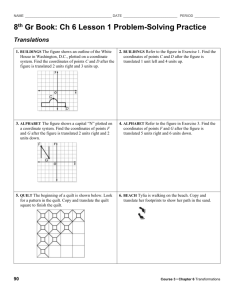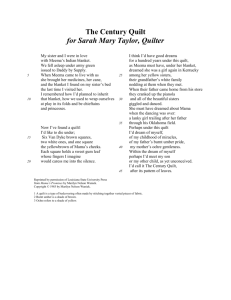The Quiltmaker’s Gift – Discovering Happiness
advertisement
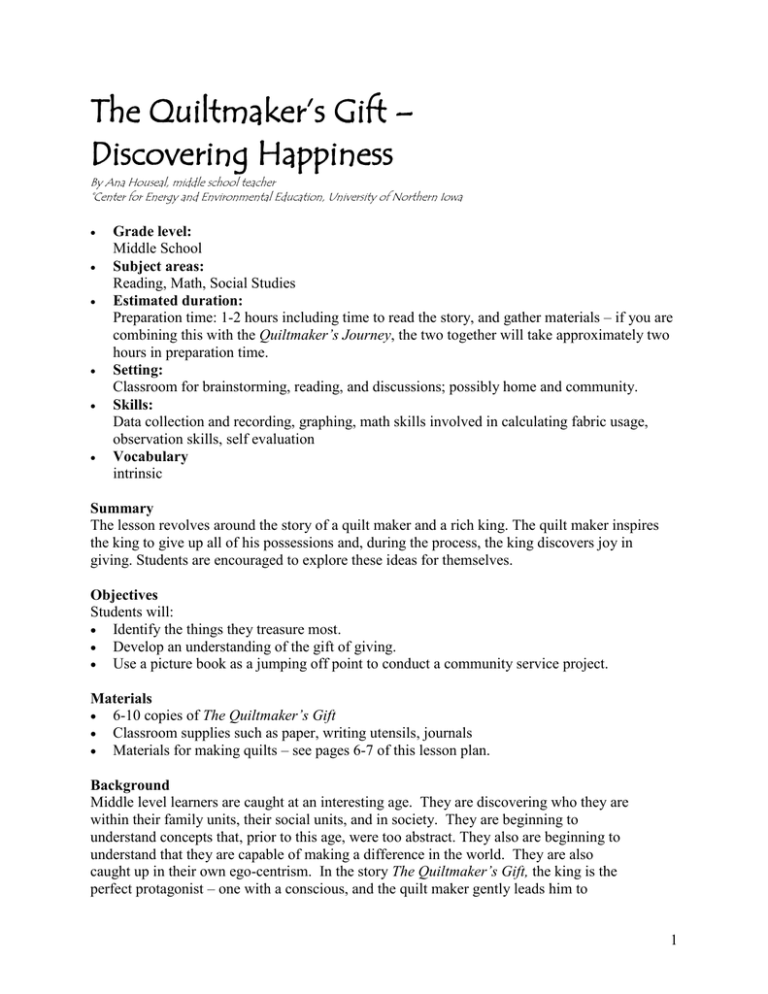
The Quiltmaker’s Gift – Discovering Happiness By Ana Houseal, middle school teacher ©Center for Energy and Environmental Education, University of Northern Iowa Grade level: Middle School Subject areas: Reading, Math, Social Studies Estimated duration: Preparation time: 1-2 hours including time to read the story, and gather materials – if you are combining this with the Quiltmaker’s Journey, the two together will take approximately two hours in preparation time. Setting: Classroom for brainstorming, reading, and discussions; possibly home and community. Skills: Data collection and recording, graphing, math skills involved in calculating fabric usage, observation skills, self evaluation Vocabulary intrinsic Summary The lesson revolves around the story of a quilt maker and a rich king. The quilt maker inspires the king to give up all of his possessions and, during the process, the king discovers joy in giving. Students are encouraged to explore these ideas for themselves. Objectives Students will: Identify the things they treasure most. Develop an understanding of the gift of giving. Use a picture book as a jumping off point to conduct a community service project. Materials 6-10 copies of The Quiltmaker’s Gift Classroom supplies such as paper, writing utensils, journals Materials for making quilts – see pages 6-7 of this lesson plan. Background Middle level learners are caught at an interesting age. They are discovering who they are within their family units, their social units, and in society. They are beginning to understand concepts that, prior to this age, were too abstract. They also are beginning to understand that they are capable of making a difference in the world. They are also caught up in their own ego-centrism. In the story The Quiltmaker’s Gift, the king is the perfect protagonist – one with a conscious, and the quilt maker gently leads him to 1 discover the joy in giving. Through this book--with its rich story and stunning illustrations--the students can be inspired to look at their own lives and identify ways to make a difference. Procedure Warm-Up Ask students (either individually or as a class) to create a list of things precious to them, and why those things are precious. Encourage them to think broadly. At this point, introduce intrinsic value. The time they spend with their family, the love they receive from parents or good friends, natural athletic ability, good health—these are things that may have intrinsic value to teachers and/or students. If you have completed the Quiltmaker’s Journey lesson, the students may already have a list of their own gifts, and may offer these without much prompting. Is there anything on the list that you would give away or trade for something else? What if someone had something that was so valuable that you had to sell everything else you owned just to acquire it? Would you be able to do that? The Activity A summary of the story could be read (see page 5) and then students could read the book on their own (if enough copies are available). The book could be read in small groups (4-6) either with or without a teacher, depending on the abilities of the students to do independent small group work. The book could be read aloud to the whole group. This is especially important at the middle level. Studies show that reading aloud is one of the best ways to develop readers (presentation by Dr. Mary Bigler at the Midwest Regional Middle Level Educators Conference, October 2003). Discussion questions that could be presented when the book is finished: What did the king want? (One of the quilts.) Why? (He did not have one – the fact that they were not for sale made them even more valuable to the king.) What did the king really want? (Happiness, which he thought he could find in possessions.) He used two methods to try to get his way. What were they, and did they work? (Putting her in a cave with a hungry bear, and putting her on a tiny island in the middle of the sea. The quilt maker used the opportunities to give something to the animals, and in return they saved her.) What was the deal that the quilt maker made with the king? (Each time you give something away, I will sew a piece of your quilt.) What did the king discover? (Giving his things away made him happier than owning them.) What did the king give to the quilt maker? (His throne–comfortable for sitting in while she made quilts.) What happens to the king at the end? (He delivers quilts for the quilt maker as he has discovered that giving makes him the most happy.) 2 The king determines that giving makes him happy. On a piece of paper, write down one to three ways you give that makes you happy. (Possible answers: Helping with chores at home, volunteering, doing someone a favor, treating someone extra special on their birthday, writing a kind note to your mother/father/guardian, giving away toys you don’t need.) When everyone has written an answer, share answer with an elbow partner, and then share several examples with the large group. On the same piece of paper, write down one to three creative gifts you can give at upcoming celebrations (birthdays, graduations, etc.) or holidays. You can: 1) share something that own that you know a friend or family member would enjoy; 2) make something; 3) buy something used; and/or 4) give an experiential gift. See Gratitude Letter as a Gift, Finding Used Gems and, for older students, see Give Gifts of Experience. (Parents may also be interested in these giving ideas.) If you also read The Quiltmaker’s Journey – How were the quilt maker and the king’s journeys similar? How were their experiences different? (They both had more things than they could possibly want, and it made neither happy. They both discovered happiness in giving. The quilt maker’s journey was different than the king’s in that it started with motivation that came from inside of her; the king’s journey needed a ‘kick-start’ from the quilt maker. The end result was the same.) What do you suppose is the author’s purpose for this story? In what ways was it different than the one of The Quiltmaker’s Gift? How is it similar? Is this story realistic? Do possessions indeed make people happy? Wrap-up and Action When the quilt maker made quilts, why did she give them in the manner that she did – in the middle of the night, rather than in broad daylight? (One reason might be that she was trying to help those in need without drawing attention to them. The loss of dignity of being homeless, penniless, and feeling unloved can become greater if one feels pitied. Giving the quilts anonymously allows the receivers to retain some of this dignity.) What gifts do we have that could be shared with our community? Which ones could be given anonymously? Which ones could not? Could we make a beautiful quilt? Is it necessary that it be beautiful? The quilt maker discusses this in The Quiltmaker’s Journey – find the passage, and see if you agree with it. If your class decides that they want to make a quilt, the pages that follow include some of many ideas on how to do this in the classroom setting. There are many more ideas – figure out which ones will work best for your group and setting, and have fun! Assessment The assessment for this lesson can be done in a number of ways. Several examples are presented below: 1. Students’ written answers to discussion questions (above) could assess understanding. 2. Assign students to write about the following: a. What do you treasure the most? 3 3. 4. 5. 6. b. How do the things you treasure affect decisions you make? Think of an example and explain it. c. Compare the journeys of the king and the quilt maker in The Quiltmaker’s Journey. How are they similar? How are they different? Ask students to do a “picture walk” of the book then answer the following questions: a. How do the pictures help tell the story? b. If you were to hear the story without pictures, how might that affect your understanding of the story? Ask students to write an essay on their own experiences of giving without being recognized and their feelings about this type of giving. Find another picture book with common themes and compare the two, or read the book to a younger audience. Note that the themes discussed by middle level learners may be too advanced for some younger groups, who will understand the basic themes, and enjoy the story lines and pictures. If the class makes the quilt (additional activity), each student could write a paragraph or two explaining the reasoning behind giving anonymously, and how it fits with the story. Extensions 1) Ask students to think about possessions they own that they would be willing to give away. On various colored 4 x 4 paper stock, each student may draw the item(s). The “quilt blocks” could be taped together on a wall in the classroom or in the hall. 2) Groups of students could explore further their own gifts for the community and turn them into service projects. Often there are funds available to get service projects started. The class may decide as a group if their service will be in the tradition of the quilt maker, or if they will make it known that they are giving a gift. 3) Schools and classrooms are in constant need of small jobs—set up a program where students look for ways to make life easier for others in school. The idea would be to do it without any compensation. 4 Quiltmaker's Gift Used with permission of Susan Elledge, Kindergarten, Edgewood-Colesburg Schools (Retrieved from www.uni.edu/~webarch/wr2005/0069.html, July 19, 2005.) One of the most beautiful books we've ever seen is The Quiltmaker's Gift which celebrates the joy of giving. A quilt maker lived high up in the mountains. She sewed away day after day making the prettiest quilts anyone had ever seen. Some said they were so pretty that she had magic in her fingers. But even though people climbed up high up to her with pockets full of gold, she would NOT sell them. On cold, dark winter nights she would go down the mountain and find a homeless person fast asleep. She would gently tuck one of her quilts around them and tiptoe away...to begin a new quilt. Now, also in this time there lived a powerful and greedy king who really liked getting presents. The hundreds and thousands of gifts he got for Christmas and his birthday were not enough. He wasn't happy. So, he passed a law that said HE could have two birthdays a year! He got so many things that he nearly had everything in the whole kingdom--but he still wasn't happy. Then he heard about these special quilts and just knew that one of those was what he needed. So, he decided that what he really, really, REALLY wanted was one of those beautiful quilts, and THEN he'd be happy. His soldiers said, "She only makes them for the poor, Your Majesty. She will not sell them for any amount of money." But the king roared, "Well, we shall see about that." But no matter what he said or did to her, she held fast and said, "Make presents of everything you own and then I'll make a quilt for you." "I can't do that," cried the king. "I love all my wonderful, beautiful things." "But if they don't make you happy," the woman replied, "what good are they?" So, the king thought about it for a long, long, LONG time and finally gave away...a marble. The boy who received it smiled so brightly that the king decided to try to give away some more. Each time he did, he sent a sparrow back to the quilt maker, and she fashioned one piece of his quilt. Did the king give all of his possessions away? Did the quilt maker teach him how to be happy? For more discussion questions, refer to that section above. 5 Making a Class Quilt Materials needed: Quilt books (for example of blocks) Scissors for cutting fabric Cloth – washed – all of one type is best (i.e. 100% cotton, or all 50-50% poly blend) Patterns for making blocks Needles and thread, or access to sewing machines Yarn for tying the top to the bottom and batting Batting (see below for other ideas) Backing for the quilt This could be expanded in numerous ways to use math skills–i.e., calculate the size of the quilt, the size of the blocks (including the seam allowances for both the pieces as well as the blocks). For a class of approximately 24, each student could make a 12.5” X 12.5” block – the finished size of the quilt would then be 4’ x 6’ -- altering for different size groups is easy – for 30, the quilt would be 5’ x 6’. To make it more uniform, no matter which patterns are used for the blocks, a similar pallet of colors could be used – a pallet in which no two colors would clash if they end up next to each other. Fall colors such as greens, oranges, reds, browns and tans would work well – or any other group of colors that go well together. It might be beneficial to involve the art teacher at this point. Another idea for fabric, which also follows the waste reduction theme of the unit, would be to reuse garments. This could be done with shirts (although knitted fabric usually doesn’t work very well) or jeans. Collecting old jeans could become a class or school project. Each pair could be cut into squares of various dimensions as they arrive (3 x 3” 4 x 4”, 5 x 5” – or with seam allowances 3.5 x 3.5”, etc. Usually a ¼ inch seam allowance is used in piecing together quilts). Various colors of denim or various shades of blues could be arranged to make a stunning and warm quilt. Although quilting is the stitching that is done to hold the pieced front to the batting and backing, this can be very time consuming. A very nice comforter can be made by tying the three sections together using yarn at various (usually evenly spaced) locations on the quilt. The batting can be purchased. There are specific types sold in fabric stores, some are even made of recycled materials, but this part of the quilt can also be replaced by a wool or tightly woven cotton blanket that can be purchased at a consignment store. The only caution with this would be to make sure the blanket is washed and dried prior to putting it into the quilt, or it could shrink inside the quilt. It is also good to avoid colors that could bleed, such as reds and dark blues. Backing for the quilt can also be purchased at fabric stores. They sell material which is specifically made for this purpose, and is wide enough, not needing piecing. Another idea for 6 backing is using high quality sheets – king sized, which also can be purchased at consignment shops. Again, remember to wash and dry them first. Plain sheets work better than patterned ones. In order for students to feel like the patch they make is theirs, they could be given choices of different patterns. Other ideas might include having students use fabric crayons to design plain fabric for their blocks. Instructions for putting together (or piecing) blocks could be put on cards and placed in an area in the room where they could be worked on independently – or they could be sent home in kits as homework projects. Putting together the final quilt could involve group decisions on ways of arranging the blocks in aesthetically pleasing ways. The actual sewing and tying could be done by the teacher, a volunteer, or possibly the Family and Consumer Science teacher could become involved. Another possibility is to invite quilters from the community to join students in piecing together the quilt. 7

